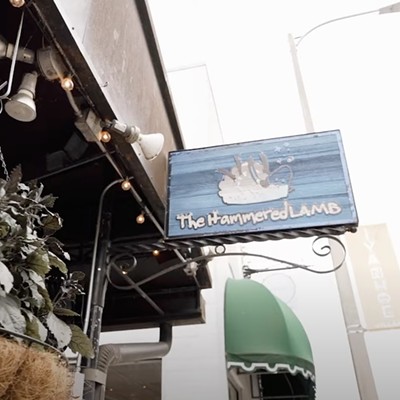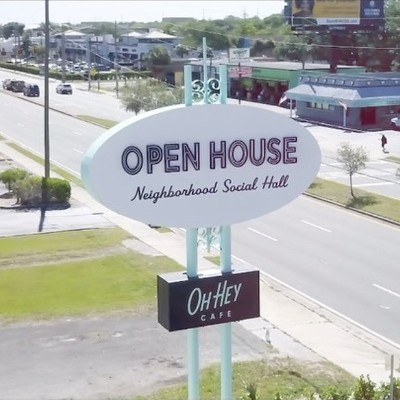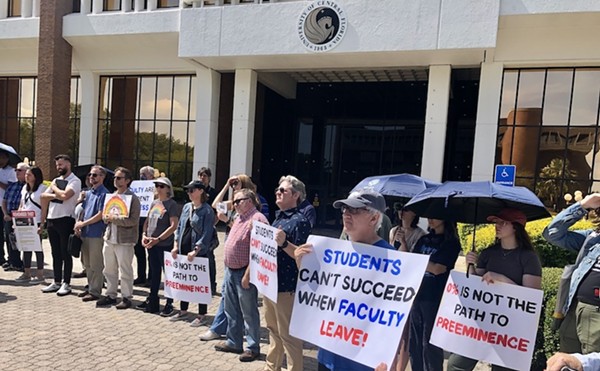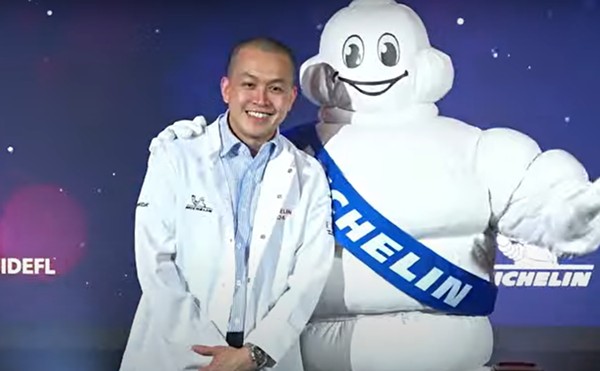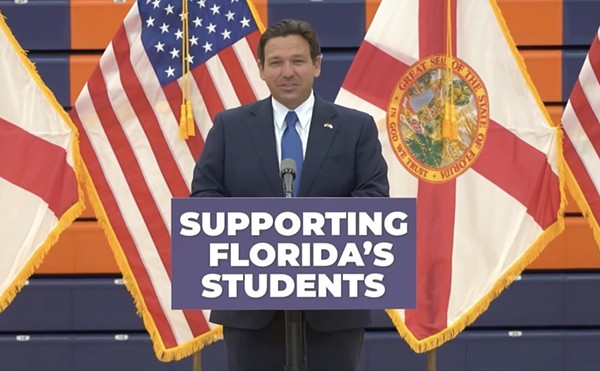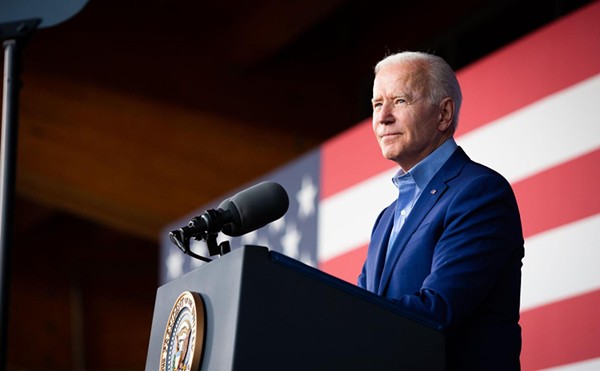Jeffrey Henschel was going to die. It was a matter of when, not if. He needed help. Such was his mother Barbara Henschel's frame of mind in 1999.
In retrospect, says Barbara today, Jeff was a typical 13-year-old, perhaps a little moodier and more rebellious than most. And in retrospect, there was no reason to suspect that her son was even using drugs. (Jeff does admit to smoking pot a few times, however.)
Why the vastly different viewpoints? Two reasons, says Barbara: Both she and her then-husband, Claude, have been through Alcoholics Anonymous and are prone to overreact to evidence of drug abuse in their son; and they got an earful of bad advice from an Orlando drug-rehab program they were told was one of the best in the country.
The Henschels' problems began when Barbara found what she thought to be pills in her son's room. (She learned later that she'd found vitamins.) Barbara consulted the private counselor that she hired to treat her son's behavior problems. The counselor said Jeff didn't have a drug problem. But she pressed, and the counselor referred them to Kids Helping Kids, an eight-month rehab program in Milford, Ohio, close to the Henschels' Cold Springs, Ky., home.
Barbara called and got the stiffest sales pitch she'd ever heard. "If he doesn't get help right away he'll die," the receptionist told her. Barbara hung up the phone an hour later, convinced Jeff was in trouble. But she still had concerns: For one thing, the family planned to move to Tampa in two months, meaning Jeff would be thousands of miles from his family. For another, Kids Helping Kids wanted a whopping $14,000 for the first month, and $900 a month after that.
A representative from Kids Helping Kids called Barbara almost daily for two weeks, assuring her that insurance would cover 80 percent of the cost, and that Jeff could attend a similar program, SAFE, in Orlando. Barbara was sold. Her son was a drug addict and his life was on the line. She cut the initial $5,000 check and had her husband Claude fly with Jeff to Orlando. He enrolled at SAFE May 2, 1999.
When she removed him from the program four months later, Jeff was a different kid. He was pale and acne-ridden after being denied sunlight his entire stay. He had more than 90 infected, self-inflicted scars on his body, many of which are still visible today. He was 30 pounds lighter, and had high levels of the attention-deficit disorder drug Adderall in his system; so high, doctors later told Barbara, that he would have died if he stayed longer.
Jeff's psychological scars were even worse, says his mother. He left SAFE addicted to Adderall and the anti-depression drug Paxil. And he was convinced that at any moment SAFE's staffers and clients would come get him. His first night out, he walked around his mother's house muttering, "I'm in relapse, I'm in relapse." He asked his mother's permission to use the bathroom, then asked if she was going to watch him as he went.
Jeff was later diagnosed with post-traumatic stress disorder. He hadn't had a full-night's sleep since he enrolled.
Jeff later spent two weeks at Wellspring, an Albany, Ohio facility that specializes in deprogramming brainwashed ex-cult members. Six months of conventional therapy followed. Even today, it's obvious Jeff's days at SAFE still haunt him. He's not alone.
Interviews Orlando Weekly conducted with several past participants paint a troubling picture of clients emerging from SAFE with little self-esteem and few skills to stay off drugs. (Citing privacy concerns, SAFE administrators denied the Weekly direct access to the program, and all but one handpicked client.)
SAFE -- Substance Abuse Family Education -- has been controversial since its 1992 inception. It rose from the ashes of Straight Inc., an organization that was part of a chain of teen rehab centers plagued with allegations of mental cruelty, and physical and sexual abuse.
Though SAFE executive director Brian Seeber distances his organization from its predecessor, he acknowledges that it follows the same controversial "tough love" model of treatment. SAFE is based on the premise that teens can beat addiction with a daily regimen of intense peer confrontations, confessionals and strict rules of conduct.
Critics call the organization a cult-like fraud that preys on fearful parents to the tune of $25,000 a year. They say SAFE makes both parents and kids dependent on the program by drilling home the idea that if teens leave the program, they die.
To the Henschels, the cure was far worse than the disease. In December 2001, they filed a lawsuit in federal court in Orlando seeking more than $1 million in damages. As the case slowly moves toward trial, they and several other former SAFE parents and clients are asking the state to shut SAFE down.
"If you get to know about `SAFE`, you know it's crap," says Kamal Manoly, a Maryland man who joined the Henschel's lawsuit after he says SAFE turned his family against each other. "They break down the kids and try to rebuild them in their mold. They destroyed my family."
A troubled past
The goings-on at SAFE pale in comparison to the methods used by its predecessor, Straight.
From 1976 to 1993, Straight was the most prevalent "tough love" treatment program in the country. At its peak, the St. Petersburg-based Straight had facilities in Ohio, California, Michigan, Georgia, Virginia, Texas, Maryland and Massachusetts. Florida had Straight programs in Sarasota, Orlando and St. Petersburg.
But Straight had many detractors. Lawsuits and news reports from across the country portrayed a program fraught with allegations of physical and sexual abuse. In some instances teen-agers, even those without substantial drug problems, were held against their will for months. Clients were watched in the shower, in the bathroom, while they dressed and undressed. They had to ask permission to pick up eating utensils and wipe after using the bathroom. Kids who didn't conform were sometimes forced to sit in their own urine, feces, menstrual blood and semen. Making eye contact with a member of the opposite sex was grounds for "immobilization," meaning other clients and staff would sit on the offenders.
In 1983, Straight-Sarasota closed amidst a state attorney's investigation into alleged physical abuse. All of its clients and staffers were transferred to the Straight-St. Petersburg facility. In 1991, the Springfield, Va., branch closed down under state investigation and reopened three days later in Maryland.
In 1989 Florida's Health and Rehabilitative Services Department denied Straight-St. Petersburg's yearly license renewal and gave the organization three months to fix problems of inadequate restraints, client privacy and poor record keeping. In 1991, HRS cited Straight-Orlando with many of the same concerns. In both cases, the problems were addressed and the license granted.
Lawsuits against Straight-St. Petersburg alone were numerous. In 1985, a woman reached a $37,500 settlement with Straight after charging false imprisonment and abuse. In 1983, a jury awarded another man $220,000 for false imprisonment. In 1990, another jury gave an ex-client $721,000 after Straight administrator Miller Newton threw her into a wall.
In 1992, HRS responded to allegations made by Richard Bradbury, a former Straight client and staffer-turned-activist who says he witnessed brutal, yet routine beatings and sexual misconduct before leaving in 1985. On May 19, 1993, HRS acting inspector general Lowell Clary issued a report which side-stepped Bradbury's claims of abuse and instead focused on the political clout of Straight co-founder and Republican Party favorite Mel Sembler. Clary insinuated that Sembler, and other high-profile politicians, leaned on HRS to grant Straight-St. Petersburg its license despite misgivings of the department's on-site investigators.
But Straight was history by the time Clary's report came out. A month earlier, on April 13, Straight Inc. -- the national headquarters -- and Straight-St. Petersburg relocated to Atlanta. (Both closed a few months later.)
Straight-Orlando shut its doors on August 14, 1992, nearly a year before Clary's report. But it re-opened for business the same day, in the same facility with the same administration. The only real difference was the name: SAFE.
By any other name
SAFE's clients -- 18 at last count -- spend their days at the South Orange Blossom Trail offices and their nights at the homes of program parents, known as "host homes."
A typical day for clients starts at 5:15 a.m. or earlier, depending on where the host home is located; some are as far away as Tampa or Daytona Beach. Even so, clients have to be at SAFE by 6:30 a.m.
At the office, the first order of business is the morning "rap" in which SAFE's staff (usually SAFE clients who have graduated from the program) read a morning meditation and lead a discussion on the "basics," based on a 12-step recovery model. Then newcomers go to SAFE's three-hour home school, and then on to an hour of Marine Corps-style exercise.
"Oldcomers" -- clients who have been at SAFE for a while and have advanced in the program -- head to public high school or to volunteer at homeless shelters and hospitals. (Prior to phase three, clients are denied sunlight and never venture outside of SAFE's confines during daylight.)
There are two afternoon "raps." Both are confrontational and intense. Clients are told to "get honest" and confess past transgressions. At 5 p.m., there's a lighter night rap, where the clients perform skits and, executive director Seeber says, unwind before heading to their host homes. They leave at 6:15 p.m., but the day isn't over yet.
At host homes, the clients eat and do chores. TV and radio are typically banned. Then they have to write their "moral inventories," a holdover from Straight derided by SAFE's critics. At night they sleep in bedrooms with alarms on the doors and windows.
Of the 18 clients now at SAFE, 10 are in the program's first, and most restrictive, phase. (There are five phases total, none of which has a specific time frame. Clients advance when the staff thinks they're ready.) By design these teens are stripped of decision-making ability and most of their dignity. They have to ask permission to speak, eat, shower and even to use the bathroom. They're not permitted to read (though they can ask an oldcomer to read either the Bible or rehab-related books to them). On trips to and from host homes, newcomers must keep their heads down to avoid reading billboards.
Jeffrey Henschel spent his whole stay in the first phase. He says he hated SAFE the moment he walked through the door. He said "hello" to a receptionist who ignored him. Then he was shuffled off to a back room for an intake interview where group staff grilled him for an hour. They were particularly interested in his sexual history, he says. Then they strip-searched him and watched him pee in a cup.
He quickly learned to sing songs praising SAFE -- "We're at SAFE feeling great" -- at the daily group sessions. In the raps, he says he was pressured to confess to sexual and drug-related deviance, mostly things he'd never done. When Jeff came clean about smoking pot, he says a counselor came back with, "No you didn't. You did other drugs!"
"They were trying to force me to come up with, 'I did opiates,' or something," Jeff says.
Misbehaving wasn't limited to tangible acts, he recalls. Counselors also urged clients to divulge "singing or cussing" in their heads. Lack of contrition was itself a form of misbehavior, and those who didn't yell at the unreformed -- SAFE calls it "motivating" -- were misbehaving themselves.
"I misbehaved since day one," Jeff confesses. "I wouldn't do jack shit. I saw no point in working."
His attitude landed him in "blackout." No one -- parents, counselors or peers -- was allowed to speak with him for three months. When he spoke, no one answered. The lack of interaction made him paranoid. He was thrown into the "time-out room," which he describes as a cold, urine- and blood-stained, concrete-floored closet. "I sat in there, every day all day, for a week with no dinner," Jeff says.
To get attention, and force SAFE to contact his mother, Jeff began cutting himself with his own fingernails. SAFE didn't treat the cuts, he says, and they became infected. Barbara Henschel recalls that the director told her about the self-inflicted wounds, saying, "We don't play those games."
When Barbara came for the weekly Friday meeting, counselors wrapped Jeff's arms in tube socks to hide the cuts. She was kept physically separated from Jeff, so she couldn't talk to him about his condition. "If I saw `his wounds`, I would have pulled him from the program," Barbara says.
According to critics, SAFE's modus operandi is to break down the client's self-esteem so they become psychologically dependent on the program. Clients were told their parents wouldn't love them if they weren't in SAFE, that they were the "worst of the worst" and would die if they left. They were denied a full nights' sleep and, according to Jeff Henschel, most were loaded up on prescription drugs. (Seeber says that only seven of his 18 clients are on psychotropic drugs.)
Parents become equally dependent. Typically, SAFE is recommended through friends or counselors -- people they trust -- so they're inclined to believe anything the program says or promises.
At first, things typically improve. "The chaos stops," says Joan, a parent who asked that her name be changed. "The running away from home, the police at your door. You can finally get a good night's sleep."
Joan's stepson, who we'll call Andy, enrolled in SAFE in October 2000. He faced either 18 months in juvenile detention or drug rehab after an arrest, and the Jacksonville family opted for SAFE. Insurance wouldn't cover the program so the family sold its boat and applied for grants from the Anchor Foundation, a nonprofit that raises money for poorer SAFE parents.
Andy stayed for two years. His parents were denied unsupervised conversations. But Joan's husband Dave trusted the program completely. So completely, that when SAFE beckoned, Dave pressured Joan to put their daughter into the program though she had no history of drug abuse. SAFE, in fact, threatened to boot Andy if Dave didn't enroll his step-daughter.
"I felt brainwashed," Joan says. But she asked her daughter to enroll for 30 days anyway. She refused. At a SAFE meeting with the whole family, SAFE staffers instructed Joan to take away her daughter's car keys and tell her if she refused to enroll, she couldn't come home. "That's when I began to see what the program was like," Joan says.
But questioning SAFE's methods got Joan ostracized. Other parents "stood her up" and yelled at her to "not talk behind backs" or discuss what was happening with her stepson's treatment. Counselors eventually banned her from parent meetings.
Her husband Dave, meanwhile, left their Jacksonville home, moved to Orlando and set up his camper as a host home. After two years Andy -- who had become so depressed that SAFE put him in the hospital -- called Joan and asked her to pick him up.
"He doesn't talk about it," Joan says of Andy's stay. "I can see that there are disturbing things to him. They broke `him` down, but they failed to build him back up."
"I know for a fact I was brainwashed," says another ex-SAFE parent, a registered nurse who says she's $50,000 in debt to SAFE. "When my daughter commenced after 26 months, she was so traumatized by all the violations, the abuse, that she almost killed herself. It's a fucking nightmare of an institution."
A hell of a shot
When Seeber brought his eldest son Paul, then 17, to Orlando in 1997, he wasn't aware of SAFE's connection with Straight. He didn't know that SAFE was founded by Straight-Orlando's program administrator Michael Scaletta and marketing director Loretta Parrish. (Soon after, Parrish bought Scaletta out and incorporated as Associated Counseling and Education Inc., a for-profit company that operated SAFE from 1993 until summer 2002, when it dissolved.) He knew nothing of Straight's history of abuse. He did know his son needed help.
Four years later Seeber was such a believer that he left his lucrative job as a Maryland bankruptcy attorney, moved to Orlando and incorporated the nonprofit S.A.F.E. Inc., the next legal incarnation of SAFE. He and Parrish decided that, as a nonprofit, SAFE could better compete for financial grants. In early 2002, Parrish decided she couldn't work with the nonprofit's requisite board of directors and left. The board put Seeber in charge.
Seeber is a thin man with wide eyes and salt-and-pepper hair. The day we met he looked professorial, and a little haggard, in a tweed jacket and dark slacks. He delayed our interview for three weeks after I first contacted him, but once we met he was emphatic and direct. "I have thought a lot about this," he wrote in an e-mail before the interview. "To be honest, I have some strong reservations about doing the interview."
Judging by my visit, neither Seeber nor SAFE is accustomed to company. Buried behind a maze of low-rent shopping centers along South Orange Blossom Trail, SAFE's home is as nondescript as they come. Only small lettering on the door marks the otherwise generic office.
"May I help you?" the receptionist asks curtly, clearing wondering what I'm doing there.
It's a stuffy room. There's a cardboard box marked "urine samples" and an odd, three-by-five card taped on the receptionist's desk that reads, "Hi, my name is -- can't say -- glad to meet you."
After two minutes, Seeber emerges, and upon ensuring I've signed the required privacy agreement, leads me directly into the sparse conference room. We see no clients along the way -- though midway through our three-hour interview, I hear them through the walls singing a lyric that's hard to make out. My interaction with SAFE's clientele is limited to the fourth-phaser Seeber provides for an interview and a runner that fetches paperwork for him: Both are dressed alike, in solid, dark-colored shirts and khaki pants, with neat hair cuts and clean-shaven faces.
It's easy to understand why Seeber's sold on SAFE. In painful detail, he describes how his son Paul's drug use tore his family apart, how he and his wife separated, how Paul threatened to kill him with a steak knife, and how SAFE worked when nothing else did. Paul now works with him at SAFE and has been sober for five years.
Seeber doesn't like to talk about his younger son, Andrew, who graduated from SAFE in 1998.
SAFE isn't always pretty, admits Seeber; it still relies on intense peer confrontation. But he's curtailed the profanity and sexual comments common with Straight. And while some clients do become dependent on the program itself, he says, the same thing happens in Alcoholics Anonymous.
(Interestingly, Seeber provides me a book called Gone Way Down by Dr. Miller Newton, a former Straight administrator who went on to form the spin-off organization, KIDS. The book, Seeber says, provides the basis for his philosophy of drug abuse. In sum, Gone Way Down provides a simplistic overview of adolescent drug culture that assumes that even recreational drug use is drug abuse and, in Newton's words "terminal." Aside from the aforementioned $721,000 judgement against Newton for abuse in St. Petersburg in 1983, he also lost a $4.5 million verdict in New Jersey in 1998 on similar abuse charges. "I never met the man," Seeber says. "But I read the book 150 times.")
Seeber also denies allegations of sleep deprivation. Yes, clients go to bed at 11 p.m. and have to wake up at 5:15 a.m. or earlier, but Seeber calls complaints that kids get two to three hours' sleep "crap." The good outweighs the bad, he says.
Still, SAFE's enrollment is dropping. In July 2000, there were 33 clients in the program; by July 2002, there were only 24. Today, with enrollment at 18, SAFE has more employees than clients. Seeber blames the decline on the fact that many insurance companies no longer cover long-term drug treatment for juveniles.
Seeber has no figures on the efficacy of SAFE. When he arrived, he heard that 70 percent of graduates were still sober one year after commencement. But kids who do graduate have a "hell lot of a stronger shot `at sobriety`," he adds.
Legal recourse
For Barbara Henschel, the last straw came when a SAFE parent wanted her credit card number. Counselors had put her son on Paxil -- without her consent, she says -- and now needed to pay to get the prescription filled.
So she and her husband Claude decided to pull Jeff out. Their own psychiatrist warned them: "Be careful when you pull him out, he's not the same kid." They didn't know what to expect. They thought they'd have to kidnap their own son.
The Henschel's went to SAFE early on a Tuesday morning on August 28, 1999 and demanded to speak to Jeff's counselor. Barbara was told by the desk clerk to go through SAFE's chain-of-command, meaning she should make her request at the lowest levels of the bureaucracy and wait for it to filter up.
"I'm pulling Jeff," she replied. "I want everything he has."
SAFE let their son go, but demanded that the Henschels come up with $17,000 to settle the bill for his treatment, she says. They didn't have the money, so SAFE agreed to bill them for the next 18 months until the debt was settled. Barbara eventually began writing "take us to court" on the bills and sending them back unpaid.
The Henschels filed their lawsuit in December 2001. (Because they cited the federal Racketeer Influenced and Corrupt
Organizations Act in their lawsuit, it went to federal court instead of state court.) The case is still in preliminary stages -- SAFE filed a motion to dismiss Aug. 9, 2002, and Judge Gregory Presnell ordered the Henschels to amend their allegations on Oct. 28. SAFE has since filed another motion to dismiss.
"I am not real optimistic about the outcome of the lawsuit but at least we will be a thorn in their side for a while," says Barbara.
In the end, the lawsuit's really not about money anyway, she adds. "I want them closed down. I don't want any more kids to go through that."


